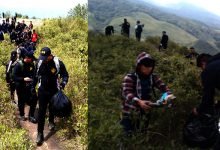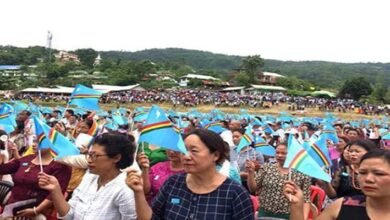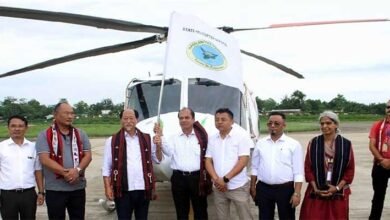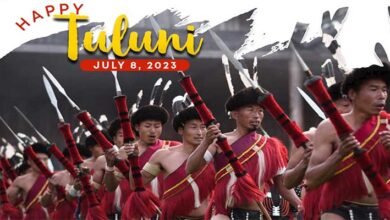Nagaland: Asian Giant Tortoise Rewilded to a protected forest

KOHIMA- Nagaland Forest Department (NFD), Turtle Survival Alliance (TSA) and Wildlife Conservation Society India (WCSI) today announced the rewilding of ten captive-bred juveniles of Asian Giant Tortoise (Manouria emys phayrei) into a protected forest of Nagaland namely Intanki National Park in Northeast India. This first monitored rewilding of the Critically Endangered tortoise in India comes after over five years of conservation breeding efforts at Nagaland Zoological Park, Dimapur.
Earlier in December last year, ten captive-bred individuals were released in the Matamuhuri valley, Chattogram Hill Tracts of Bangladesh by the TSA and Creative Conservation Alliance. Together the two release events by the partner organizations in India and Bangladesh, will produce the necessary scientific information for developing the long-term monitoring and eventual release strategy for species supplementation throughout their historic range in South and Southeast Asia.
A long history of over-exploitation and a general lack of awareness leading to unsustainable use for consumption by local communities have brought the species to the brink of functional extinction warranted rigorous conservation interventions. “Nagaland Forest Department with the help of stakeholders and partner organizations is committed in long-term program to restore an ecologically viable population of Asian Giant Tortoise in the state,” said Mr. Vedpal Singh, Chief Wildlife Warden, Nagaland. “This pilot release is a major leap towards repopulating the species”.
“Having developed successful conservation breeding programs across species’ native ranges in India and Bangladesh, with regional partners, the release of these ten tortoises is a large step into the population replenishment phase” said Dr. Shailendra Singh, Principle Investigator of joint Asian Giant Tortoise Recovery Project. “The exercise will produce first ever baseline information for developing the long term monitoring and eventual release strategy for species supplementation on the regional scale.”
Eyeing a fleeting hope to replenish the wild populations via a regional conservation breeding program with the zoos across Northeast India, some head-ways toward expanding the same were made by Nagaland Zoological Park under a joint program started with TSA in 2017 under a institutional cooperation.
“Today, Nagaland Zoological Park has the highest number of Asian Giant Tortoise population in India holding over 110 successful hatchlings and juveniles with 13 founder adults”, said Dr. C. Zupeni Tsanglai, Director, NZP.
The Asian Giant Tortoise is the largest tortoise in mainland Asia, listed as ‘critically endangered’ in the IUCN Red List of Threatened Species. Release represents the first monitored rewilding of Asian Giant Tortoise in India. Post-release animal movement and survival monitoring will be performed through telemetry. Pilot release will serve as a means to guide future release potential for rewilding and eventual population recovery of the Asian Giant Tortoise across its historic range.HIGHLIGHTS
Tracing the recent species donations at northeast Indian zoos, historic habitats and indirect evidence on-field, such rewilding events shall be conducted in multiple phases at the most probable habitats achieving eventual reintroduction of the captive reared individuals. “Currently in the first phase, animals will be soft-released or moved to a large natural enclosure with native habitat for acclimation throughout the winters and allowed to disperse into the forests at the onset of monsoon followed by active tracking by a joint project team”, said Mr. T. Aochuba, Director Intanki National Park. Soft release is described as gradual return of captive raised individuals to the wild. The goal is to generate site fidelity in the released individuals whereby they develop a tendency to remain in the vicinity of the soft release enclosure. This has proved to be an effective strategy with other species of tortoises and serves to anchor them to that site.
“These ten juveniles were born in 2018, the first batch of the conservation breeding program initiated with NZP, and have an average weight of 2.4 kg. The cohort underwent a thorough health examination by a panel of wildlife veterinarians, prior to their release”, informed Ms. Sushmita Kar, Asian Giant Tortoise project Researcher.
This long term Asian Giant Tortoise Population Recovery Program also engages with target local communities in the priority areas through awareness program, and community involvement, for sensitization against the hunting of released animals, and protection of important habitats, thus strengthening the participatory conservation initiatives and fostering sense of environmental stewardship in the identified sites inhabited by ethnic tribes who have age long tradition of protecting their local habitats as Indigenous Community Conserved Areas (ICCA).
We thank Mr. Ved Pal Singh (CWLW, Nagaland), Mr. T. Aochuba (Director, Intanki National Park), Dr. C. Zupeni Tsanglai (Director, Nagaland Zoological Park), Dr Prabhat Kumar (Former Director, NZP), Dr Michael Imti Imchen (Vet NZP), Dr Michael Tsanglao (Vet NZP) and Dr Himanshu Joshi (WCT) all staff of NFD and India Turtle Conservation Program. We also thank Mr. Rick Hudson and Mr. Nathan Haislip of Turtle Survival Alliance for technical inputs in the project.
Conservation breeding and release team members include Dr. Shailendra Singh, Dr. C. Zupeni Tsanglai, Ms. Sushmita Kar, Ms. Watisungla Amer, Ms. Sreeparna Dutta, Dr. Parimal Ray and field assistants Mr. Ika Chishi, Mr. Bhushan Lam and Mr. Lalit Mohan Budhani.
Writer is SHAILENDRA SINGH, Principal Investigator, Asian Giant Tortoise Recovery Project,











